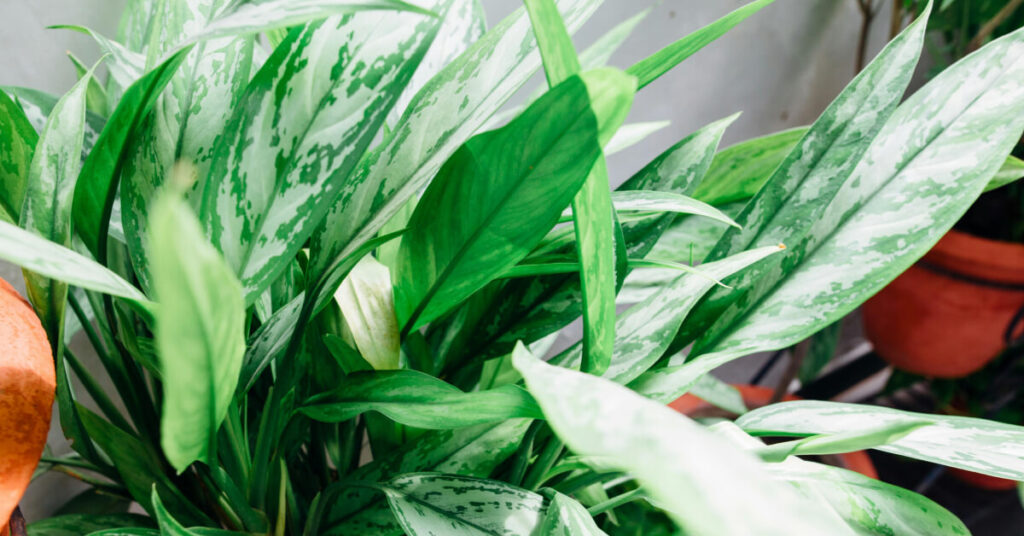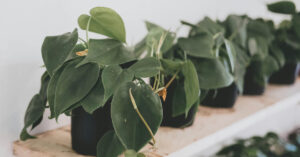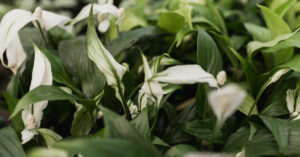Aglaonema
Chinese Evergreen stands as the undisputed master of low-light gardening, delivering spectacular colorful foliage in conditions where most plants would struggle to survive. This remarkable beauty combines stunning leaf patterns in shades of green, silver, pink, and red with almost supernatural tolerance for neglect, making it the perfect choice for anyone seeking vibrant color without demanding care requirements.
Why Chinese Evergreen Excels Where Others Fail
Native to the tropical forests of Asia, Aglaonema has evolved to thrive in the filtered light of dense forest floors, making it perfectly adapted for modern indoor environments. Its spectacular foliage displays intricate patterns of color that rival any flower, creating year-round visual interest that never fades or drops. Unlike temperamental colorful plants that lose their vibrance in low light, Chinese Evergreen actually maintains its stunning patterns in dim conditions, making it invaluable for offices, basements, and north-facing rooms.
What makes Chinese Evergreen truly exceptional is its remarkable resilience combined with genuine beauty. NASA studies have recognized it as an effective air purifier, removing harmful toxins like formaldehyde and benzene from indoor air. The plant’s slow, steady growth means it maintains its shape for years without frequent repotting, while its tolerance for irregular watering makes it perfect for busy lifestyles and frequent travelers.
Care Requirements
Light Requirements
Low to medium indirect light
Chinese Evergreen thrives in the low to medium light conditions that challenge most houseplants, making it an absolute champion for difficult spaces. While it appreciates bright, indirect light, it performs remarkably well in offices with fluorescent lighting, north-facing windows, and rooms with limited natural light. Direct sunlight can actually harm the plant, fading its beautiful leaf patterns and causing unsightly brown patches. The lower the light, the more the plant relies on its green pigments, while brighter indirect light enhances the colorful variegation.
Watering
Moderate frequency
Chinese Evergreen prefers a consistent but relaxed watering schedule that fits perfectly with busy lifestyles. Water when the top 1-2 inches of soil feel dry to the touch, typically every 1-2 weeks during the growing season. The plant tolerates both slight underwatering and occasional overwatering better than most houseplants, though consistent overwatering can lead to root rot. During winter months, reduce watering frequency as growth slows and soil takes longer to dry.
Soil Type
Well-draining potting mix
Standard high-quality potting soil works excellently for Chinese Evergreen, as the plant isn’t particularly demanding about soil composition. The key requirement is good drainage—the soil should feel moist after watering but never soggy or waterlogged. If your potting mix seems to retain too much moisture, adding perlite or coarse sand can improve drainage. The plant adapts well to various soil pH levels but prefers slightly acidic to neutral conditions.
Temperature
65-80°F (18-27°C)
Chinese Evergreen thrives in the warm, stable temperatures typical of most homes but shows sensitivity to cold drafts and sudden temperature changes. Maintain consistent temperatures between 65-80°F for optimal growth and color development. The plant is particularly sensitive to cold, with temperatures below 60°F (15°C) potentially causing permanent damage to the foliage. Keep your plant away from air conditioning vents, heating sources, and exterior doors where temperature fluctuations occur.
Humidity
Medium to high
While Chinese Evergreen adapts to average household humidity levels, it truly thrives with increased moisture in the air. Aim for 40-60% humidity when possible, using humidifiers, pebble trays, or grouping with other plants to create a more humid microenvironment. Higher humidity promotes more vibrant leaf coloration, larger leaf size, and overall healthier growth. The plant tolerates lower humidity but may develop brown leaf tips in very dry conditions.
Fertilizing
Light feeding during growing season
Chinese Evergreen has minimal fertilizer requirements, making it perfect for low-maintenance plant care. Apply a balanced liquid fertilizer monthly during spring and summer, diluted to half strength to prevent over-fertilization that can reduce the plant’s beautiful variegation. The plant can thrive for extended periods without any fertilizer, though regular light feeding promotes better color development and slightly faster growth.
Seasonal Care Adjustments
Spring/Summer (Growing Season):
- Water every 1-2 weeks as soil dries
- Monthly light fertilizing enhances color development
- Ideal time for repotting if necessary
- Monitor for new leaf emergence and growth
Fall/Winter (Slower Growth):
- Reduce watering frequency as growth slows
- Stop fertilizing during dormant period
- Lower light tolerance increases further
- Growth naturally decreases—this is completely normal
Mature Size and Growth Habits
Chinese Evergreen typically reaches 1-3 feet in height and width, maintaining a compact, bushy form that works perfectly for tabletops, desks, and floor displays. The plant grows slowly and steadily, usually taking 3-5 years to reach mature size, which means it maintains its proportions for years without outgrowing its space. Individual leaves can reach 4-12 inches long depending on the variety, creating lush, full plants that provide substantial visual impact. With proper care, Chinese Evergreen can live for many years, often becoming treasured specimens that improve with age.
Difficulty Level
Easy
Chinese Evergreen ranks among the most forgiving houseplants available, making it ideal for beginners, office environments, and anyone seeking beautiful, low-maintenance foliage. The plant tolerates care mistakes gracefully and provides subtle visual cues about its needs through leaf appearance.
Pet and Child Safety
Important: Chinese Evergreen is toxic to pets and children if ingested. The plant contains calcium oxalate crystals that can cause mouth irritation, difficulty swallowing, and digestive upset. All parts of the plant should be kept away from curious pets and small children. While not typically life-threatening, consumption can cause significant discomfort and should be avoided.
Varieties to Consider
Chinese Evergreen offers an incredible array of varieties with different color patterns and sizes:
- Aglaonema ‘Red Siam’: Deep red and green leaves with pink stems
- Aglaonema ‘Silver Bay’: Silver-green leaves with dark green edges
- Aglaonema ‘Pink Dalmatian’: Green leaves with pink and white speckles
- Aglaonema ‘Emerald Beauty’: Classic green with silver markings
- Aglaonema ‘Red Valentine’: Heart-shaped leaves with red and green patterns
- Aglaonema ‘Maria’: Silvery-green leaves with dark green borders
Plants That Pair Well with Chinese Evergreen
Chinese Evergreen’s colorful foliage and low-light tolerance make it an excellent companion for other shade-loving plants. Its compact form and vibrant patterns provide beautiful contrast in plant groupings while thriving in similar conditions.
Perfect Companions:
- Peace Lily – Similar light and humidity preferences with complementary white flowers
- ZZ Plant – Equally low-maintenance with contrasting solid green foliage
- Snake Plant – Comparable low-light tolerance with different architectural form
- Pothos varieties – Similar care needs with trailing growth habit for contrast
- Cast Iron Plant – Fellow low-light champion with different leaf texture
Colorful Collections: Create stunning displays by combining different Chinese Evergreen varieties with various leaf patterns and colors. These combinations work beautifully together while requiring identical care conditions.
Aesthetic Pairings: Chinese Evergreen serves as an excellent colorful accent plant, providing vibrant foliage that enhances green plant groupings. Its compact form works beautifully with taller plants like snake plants or dracaenas, adding color and texture to the lower levels of plant arrangements.
Common Problems and Solutions
Overwatering
Symptoms: Yellow leaves with brown spots, mushy stems, root rot, moldy soil
Solution: Reduce watering frequency, improve drainage, remove affected roots if necessary
Underwatering
Symptoms: Drooping leaves, brown crispy edges, soil pulling from pot sides
Solution: Water thoroughly and establish more consistent watering schedule
Low Humidity
Symptoms: Brown leaf tips, small new leaves, dull color development
Solution: Increase humidity with humidifier, pebble trays, or plant groupings
Too Much Light
Symptoms: Faded leaf patterns, yellow or brown patches, washed-out colors
Solution: Move to lower light location away from direct sunlight
Pest Issues
Symptoms: Spider mites, mealybugs, scale insects on leaves and stems
Solution: Regular inspection, neem oil treatment, improve air circulation
Maintaining Vibrant Colors
Preserving and enhancing your Chinese Evergreen’s beautiful leaf patterns requires attention to several key factors that influence color development.
Light Balance: While the plant tolerates low light, providing bright indirect light enhances variegation and color intensity. Avoid direct sun which fades patterns, but don’t keep the plant in extremely dark conditions where colors may become muted.
Proper Nutrition: Light, consistent feeding during growing season supports vibrant color development. Over-fertilizing can actually reduce variegation, so stick to diluted, monthly applications.
Temperature Stability: Consistent warm temperatures promote better color expression. Cold stress can cause colors to fade and new growth to emerge with reduced variegation.
Humidity Optimization: Higher humidity levels support the plant’s ability to produce its most vibrant leaf patterns. Dry air can cause new leaves to emerge smaller and less colorful.
Gentle Cleaning: Regular dusting of leaves with a damp cloth helps maintain color vibrancy by ensuring maximum light absorption for photosynthesis.
Propagation
Chinese Evergreen propagation is straightforward through division or stem cuttings, allowing you to create new plants or share with friends:
Division Method:
- Remove plant from pot during repotting (spring is ideal)
- Gently separate natural divisions with roots attached
- Each division should have several stems and healthy root system
- Plant divisions in fresh potting soil
- Keep slightly more moist until new growth appears
- New growth indicates successful establishment
Stem Cutting Method:
- Cut healthy stems with several nodes during growing season
- Place cuttings in water or moist potting soil
- Keep in bright, indirect light with high humidity
- Roots develop in 3-4 weeks
- Transplant to permanent pots once established
Your Low-Light Color Solution
Chinese Evergreen represents the perfect solution for anyone seeking vibrant, colorful foliage in challenging low-light conditions. Its combination of stunning leaf patterns, remarkable tolerance, and air-purifying benefits makes it an invaluable addition to homes, offices, and any space needing reliable color without demanding care requirements.
Whether you’re decorating a dim corner, brightening up an office cubicle, or adding color to a plant collection, Chinese Evergreen delivers consistent beauty with minimal effort. Start with one variety and you’ll soon find yourself collecting different patterns and colors, creating your own personal gallery of living art that thrives where other plants simply can’t.




